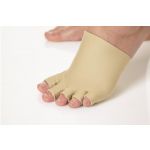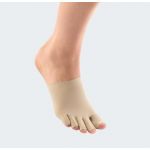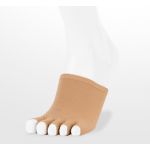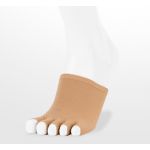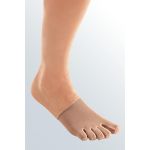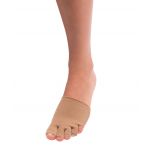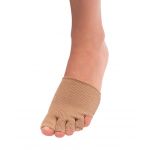Feet and Toe Compression Caps
Feet Caps And Toe Caps For Lymphedema
Feet and toe compression caps provide compression and support to the feet and toes to help manage and treat lymphedema, edema, venous insufficiencies, and other medical conditions.
The feet compression caps and toe compression caps also work well for swollen, tired, and aching feet.
Shop our feet and toe compression caps with pre-tax savings using your FSA or HSA account!
Feet Caps And Toe Caps For Lymphedema
Designed to reduce congestion in the feet by providing gradient compression, the feet caps and toe caps help inhibit the accumulation of fluid. The feet caps and toe caps are comfortable to wear, and can be used to treat swelling in the instep, the forefoot (the padded area just below the toes), and the toes.
The feet caps and toe caps are available in open-toe and closed-toe configurations, as well as a variety of sizes, colors, and materials.
Feet Caps And Toe Caps From Top Manufacturers
We have a selection of compression feet caps and toe caps from some of the top brands, including:
- Jobst Elvarex toe caps
- Jobst FarrowWrap toe caps
- Juzo toe caps
- Circaid toe caps (Circaid reduction kit toe caps)
- Medi Flat toe caps
Levels Of Compression For Feet Caps And Toe Caps
The compression feet caps and toe caps provide different levels of compression, including:
- 15-20 mm Hg of compression
- 20-30 mm Hg of compression
For more information about our feet caps and toe caps please call (800) 700-1032, or e-mail info@bandagesplus.com.
••••••••••••••••••••••••••••••••••••FAQs About Compression Foot And Toe Caps
Compression foot and toe caps are specialized garments that are designed to manage lymphedema in the feet and toes. Below are some of the most frequently asked questions about compression foot and toe caps.
- What Are Compression Foot And Toe Caps
- How Do Compression Foot And Toe Caps Help With Lymphedema
- What Other Medical Conditions Can Compression Foot And Toe Caps Help
- What Is The Difference Between Compression Foot And Toe Caps And Compression Socks
- How Do I Choose The Right Level Of Compression In Foot And Toe Caps
- How Do I Know If My Compression Foot And Toe Caps Are Fitting Properly
- Can I Wear Compression Foot And Toe Caps All Day
- How Often Should Compression Foot And Toe Caps Be Replaced
- Can Compression Foot And Toe Caps Be Washed
- Do I Need A Prescription To Get Compression Foot And Toe Caps
- Do Insurance Companies Cover Compression Foot And Toe Caps
- Does Medicare Cover Compression Foot And Toe Caps
Compression foot caps and toe caps are tight-fitting sleeves that cover the foot, toes, or both. They deliver consistent, targeted pressure that can help reduce swelling and improve lymphatic flow.
Compression foot caps and toe caps apply direct compression to the affected areas that can help promote lymph fluid drainage, prevent fluid accumulation, and maintain your foot and toe shape and function.
In addition to lymphedema, compression foot caps and toe caps can also be beneficial if you have had surgery or radiation treatments that have affected lymphatic drainage in your feet and toes. And the compression caps can also be used to treat and manage venous insufficiency, diabetic peripheral neuropathy, arthritis, gout, and other medical conditions.
Compression socks are designed to provide generalized compression along the foot and calf, whereas compression foot caps and toe caps specifically target your foot and individual toes with a higher degree of precision and pressure.
Compression foot and toe caps come in various compression levels (see above). Your healthcare provider will recommend the correct pressure level, based on the severity of your lymphedema and your medical history. The higher the mmHg level, the higher the compression.
For your compression foot caps and toe caps to be effective and comfortable, they need to fit properly. The compression should feel firm, but not overly tight. The pressure should be distributed evenly across the foot and/or toes, without any areas feeling pinched or excessively squeezed. There should not be any bunching up, which could lead to pressure points, discomfort, and restricted blood flow. You should be able to move your toes relatively easily within the cap. If you cannot, the cap might be too tight. And if your foot cap or toe cap is working correctly, you should notice a reduction in swelling.
Your healthcare provider should make specific recommendations. In general, however, compression foot caps and toe caps are worn throughout the day and removed at night.
Generally, compression foot caps and toe caps should be replaced every 3-6 months, because of stretching and the wear and tear from regular use.
You will need to follow the specific instructions from the manufacturer of your compression foot caps and toe caps. In general, however, most compression foot caps and toe caps can be washed in mild detergent, rinsed thoroughly, and air-dried. You should avoid fabric softeners and bleach, because they can degrade the material.
No. You can order all of our compression foot caps and toe caps without a prescription.
Some insurance plans cover compression foot caps and toe caps, with a prescription. Check with your insurance provider for specifics about your coverage.
Starting in January 2024, thanks to the Lymphedema Treatment Act, Medicare began covering compression products, including compression bandaging systems and supplies that are used during the initial decongestion phases and maintenance phases of lymphedema treatment. Click here to read more about the Lymphedema Treatment Act and how to order compression foot caps and toe caps.
Please note that all of the information above is for general informational purposes. Please consult your healthcare provider for specific information and personalized recommendations for your situation.
For more information about our compression foot caps and toe caps for lymphedema, please call (800) 700-1032, or e-mail info@bandagesplus.com
••••••••••••••••••••••••••••••••••••Medicare Pays For Lymphedema Products
Please note: Thanks to the Lymphedema Treatment Act, which took effect on January 1, 2024, Medicare began to pay for lymphedema products for those who have Medicare B coverage and meet certain other coverage criteria. Please visit our website page covering the details of the Lymphedema Treatment Act to obtain more information about how Medicare pays for lymphedema garments, wraps, and bandages


